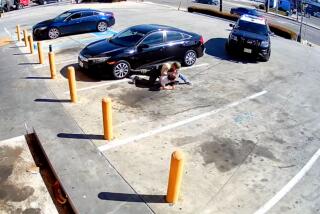L.A. County jail inmates were handcuffed to a wall for hours on ‘potty watch’

The North Facility of the Pitchess Jail in Castaic on May 19, 2010.
- Share via
One jail inmate, clad only in boxer shorts and socks, was handcuffed to a wall for up to 11 hours.
Another was cuffed to the wall for as many as eight or nine hours, causing bleeding and severe pain to his wrists.
They were among dozens of inmates at North County Correctional Facility who were chained to the wall with their hands behind their backs, half-naked or even fully naked, sometimes with their feet shackled to the floor, as jail officials waited for them to expel contraband from their bodies.
Corrections experts say the practice is improper and inhumane.
But at NCCF, a maximum-security jail in Castaic run by the Los Angeles County Sheriff’s Department, it was spelled out in writing as a required practice.
See more of our top stories on Facebook >>
The Sheriff’s Department has since rescinded the policy and referred 24 cases to the district attorney’s office for possible prosecution.
To date, prosecutors have filed criminal charges in only one case — the prolonged handcuffing of an inmate suspected of having a “kite,” or unauthorized note to another inmate, hidden in his rectum.
But advocates for the deputies argue that it’s unfair to blame low-level officials who were simply following department policy.
Contraband watch, known informally as “potty watch,” is a fact of life at jails and prisons across the country, as inmates conceal drugs, weapons and other forbidden items in their body cavities. Potty watches often become tests of patience, stretching for hours during the wait for the inmate to use the toilet.
Inmates must be prevented from secretly disposing of contraband, but there are ways to restrain them short of handcuffing them to a wall, such as securing their hands to a waist chain and keeping them under constant surveillance, corrections experts said.
The handcuffings are the latest in a series of problems facing the nation’s largest county jail system, which is under federal oversight because of a long-term failure to properly care for mentally ill inmates.
Three sheriff’s officials were recently convicted of beating a jail visitor. An additional eight officials have been convicted of obstructing a federal investigation into deputy misconduct in the jails, with the department’s former second in command scheduled to stand trial in March.
In July, 10 employees were relieved of duty after an inmate was handcuffed without food for 32 hours at the jail system’s Inmate Reception Center.
The contraband watch method at NCCF seems extreme and is not used at other facilities, said James Robertson, a corrections consultant in Denver.
“It goes back to that statement, ‘Do the ends justify the means?’” he said. “In the end, you get the contraband, but is there a better, more humane way to do it?”
The NCCF written policy had been in place since April 2014 and applied only to that facility, not the other county jails. It stated that deputies “shall” handcuff inmates to wall brackets in a seated position and that inmates’ feet “may” also be shackled to the floor.
The department policy at the time gave little guidance on how to perform contraband watches, directing each facility to develop its own rules.
“If they were in that kind of restraint for any length of time, it is absolutely abominable,” said Peter Eliasberg, legal director for the ACLU of Southern California.
When top Sheriff’s Department officials found out about the NCCF policy in February, they replaced it with a new department-wide policy specifying that inmates’ hands should be cuffed to their waists but not to any fixed object.
Fourteen NCCF employees, including the head of the facility, Capt. Anselmo Gonzalez, were reassigned to positions where they had no contact with inmates.
Through a department spokesman, Gonzalez declined to comment.
“These incidents were discovered during a routine internal audit by command staff, and we determined that they could have been handled better,” Sheriff Jim McDonnell said in a written statement to The Times. “We immediately implemented new measures and policies to ensure it would not happen again.”
Sixteen handcuffing cases have been rejected by prosecutors, including the 11-hour contraband watch and the case where the inmate sustained injuries to his wrists after being handcuffed for eight or nine hours.
In the only handcuffing incident to result in a criminal case, a sheriff’s deputy and two sergeants were charged in September with cruel and unusual punishment. The deputy, James Hawkins, was also charged with assaulting the inmate. Each charge is a misdemeanor.
A spokeswoman for Dist. Atty. Jackie Lacey released few details about the Sept. 5, 2014, incident. The inmate, Omar Estrada, was placed in a holding cell for “an extended period of time” after his return from a court appearance, said the spokeswoman, Jane Robison.
It goes back to that statement, ‘Do the ends justify the means?’ In the end, you get the contraband, but is there a better, more humane way to do it?
— James Robertson, a corrections consultant in Denver, on the former contraband watch method at North County Correctional Facility in Castaic
He was “in various stages of undress” while restrained, suffering injuries to his wrists and midsection, Robison said. She would not say how long Estrada was allegedly restrained.
Estrada, a Downey resident who was 32 at the time, had been in jail since Aug. 19, 2014, after being arrested on suspicion of petty theft with a prior conviction. He could not be reached for comment.
Hawkins, the deputy, had been with the department for three years and was taught the handcuffing protocol by his superiors, said his attorney, Vicki Podberesky.
“My client is not making the policy. He’s just following directions,” she said. “The problem is with the policy.”
Podberesky said she has viewed a videotape of the incident. In the tape, Estrada can be seen sitting on a stainless-steel bench with his hands cuffed to the wall, Podberesky said. He was checked on regularly and given food and water.
Podberesky did not know how long Estrada was handcuffed but said it was not as long as the total detention, which she believed was 11 to 13 hours.
When Estrada used the toilet, he excreted pieces of paper that could have been a note, she said.
The sole evidence for the misdemeanor assault charge was an allegation from Estrada that was not backed up by the video or physical evidence, Podberesky said.
“This was neither the longest detention, nor was there anything particular about it,” Podberesky said. “There was no abuse, nothing to suggest the individual was mistreated in any way.”
After the criminal charges were filed, Hawkins and Sgt. David Moser were relieved of duty without pay. The other sergeant, Rex Taylor, had already retired.
The new policy, which instructs deputies to create a “dry cell” with the inmate fully clothed and restrained only by waist cuffs, resembles the one used by the California state prison system.
The toilet is taped shut to prevent the inmate from flushing any contraband, and a deputy must always be present to help with food, water and bathroom needs.
Brian Moriguchi, president of the union that represents sheriff’s supervisors, said the employees in the handcuffing cases were scapegoated for following an established policy.
“The Sheriff’s Department must take responsibility for what happened to that inmate,” Moriguchi said. “It was a poor policy and a lack of training.”
Twitter: @cindychangLA
Times staff writer Marisa Gerber contributed to this report.
ALSO
A toll crossing between the U.S. and Mexico is slowly taking shape
Colorado’s pot industry is a cash business. A small credit union wants to change that.
‘Affluenza’ teen, mother detained in Mexico, officials say
More to Read
Sign up for Essential California
The most important California stories and recommendations in your inbox every morning.
You may occasionally receive promotional content from the Los Angeles Times.











